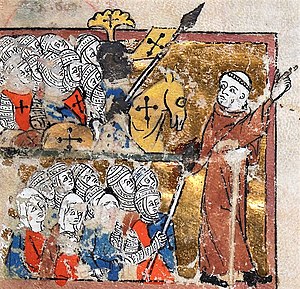User:Caravel12/Sandbox3
| Rohidian Crusade | |||||||
|---|---|---|---|---|---|---|---|
 Siôn the Brave leading the crusaders to battle. | |||||||
| |||||||
| Belligerents | |||||||
| Commanders and leaders | |||||||
|
Siôn the Brave Owain of Cwmgwrach † | XXX | ||||||
| Strength | |||||||
| ??? | ??? | ||||||
| Casualties and losses | |||||||
| ??? | ??? | ||||||
The Rohidian Crusade (1236-1251) was a 15 year campaign called by Pontiff Virgo III in order to eradicate the heretical practice of Rohidianism, a religious sect relatively based off Alydianism that was thriving within the petty kingdoms of the Wradhian realms; most notably the province of Hlaanidd administered by the Kingdom of Morwystrad. The crusade led to serious famine and unrest within Morwystrad, and caused Morwystrad to lose the region, which became part of the sphere of influence under Lletwyr, keeping it out of the hands of Vvardenese petty kingdoms, who also were involved in the crusade.
The Rohidian belief system originated from the ideas of the early Gentilians who were a sect of early Alydianism from the times of the Fiorentine Empire. They believed there was not any other manifestations of God, he was only one, but because of his wide range of emotions and attributes, he was corrupted into eight consubstantial deities. It also denied the Pontiff as the head of state, and criticized the Church for its wealth. Rohidians also practiced preaching, rejection of physical and non-holy pleasures, and even poverty in order to properly devote themselves to god and reach perfection and enlightenment.
Rohidianism was widely condemned over the last two centuries within the region, notably during the Council of Arddlech, which was the last of these councils to confirm this statement in 1179. Imprisonment and confiscation of lands were extremely common acts against any person who associated with Rohidianism. Missionary work (notably by Saint Emyr) was met with very little success. By 1192 Pontiff Andrius II even offered to fund any noblemen willing to help remove the Rohidians and help confirm that they would gain those lands.
The issue reached a boiling point in February of 1236 when Rohidians impaled Iestyn Craigwen, Bishop of Irfon on a pike. Pontiff Virgo III ordered a crusade on the region. It experienced initial success in the first 4 years (1236-1240), capturing lands controlled by Rohidian practicing nobles as well as peoples. It was then followed by an inquisition that led to the religious sect to have to go underground, and almost completely wiped out by 1267. Following the inquisition, preaching continued until the mid 14th century, when all of Rohidianism seemed to have fully expunged from Morwystrad.